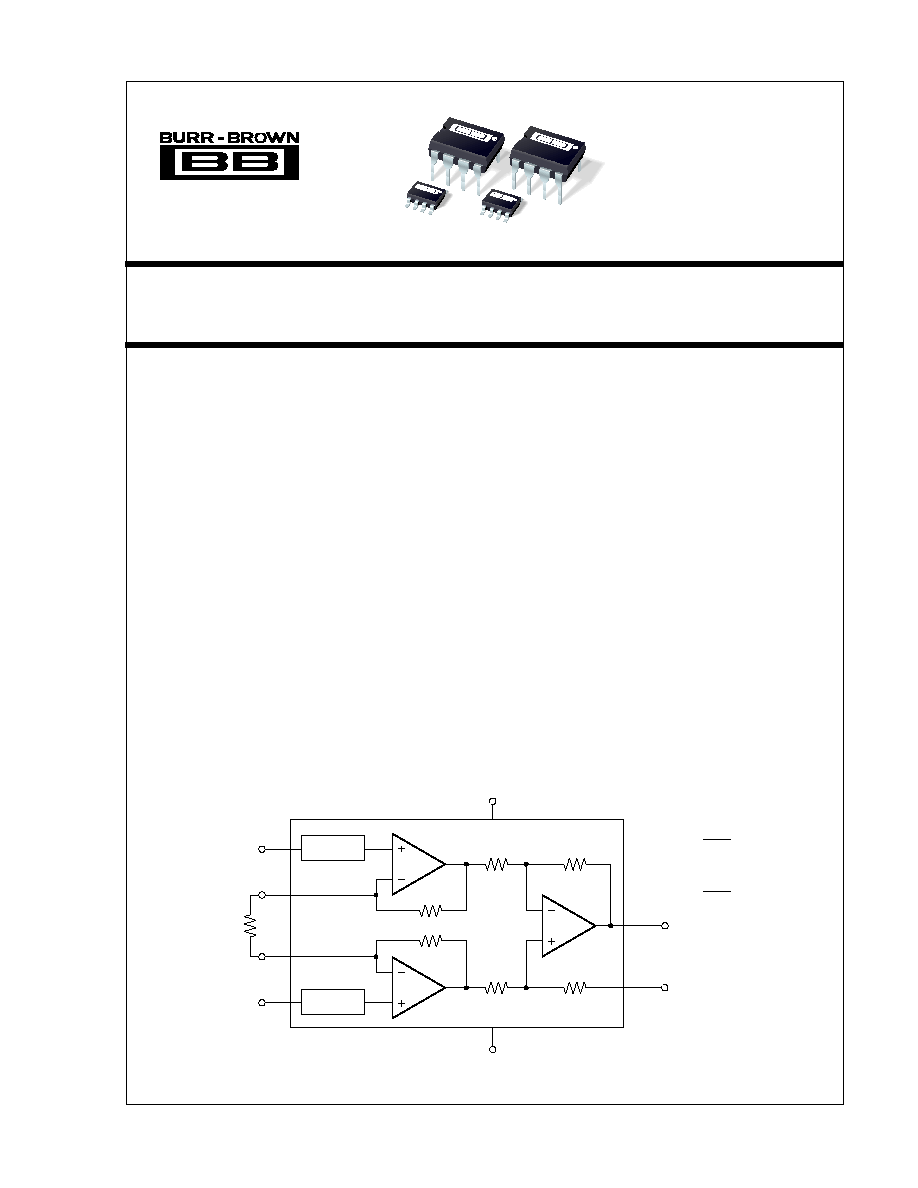
©
1995 Burr-Brown Corporation
PDS-1296C
Printed in U.S.A. October, 1996
A
1
A
2
A
3
40k
40k
40k
40k
V
IN
2
1
8
3
6
5
V
IN
R
G
V+
V≠
INA128, INA129
Ref
V
O
INA128:
G = 1 +
50k
R
G
INA129:
G = 1 +
49.4k
R
G
≠
+
Over-Voltage
Protection
25k
(1)
25k
(1)
Over-Voltage
Protection
4
7
NOTE: (1) INA129: 24.7k
FEATURES
q
LOW OFFSET VOLTAGE: 50
µ
V max
q
LOW DRIFT: 0.5
µ
V/
∞
C max
q
LOW INPUT BIAS CURRENT: 5nA max
q
HIGH CMR: 120dB min
q
INPUTS PROTECTED TO
±
40V
q
WIDE SUPPLY RANGE:
±
2.25 to
±
18V
q
LOW QUIESCENT CURRENT: 700
µ
A
q
8-PIN PLASTIC DIP, SO-8
DESCRIPTION
The INA128 and INA129 are low power, general
purpose instrumentation amplifiers offering excellent
accuracy. Their versatile 3-op amp design and small
size make them ideal for a wide range of applications.
Current-feedback input circuitry provides wide band-
width even at high gain (200kHz at G = 100).
A single external resistor sets any gain from 1 to
10,000. INA128 provides an industry standard gain
equation; INA129's gain equation is compatible with
the AD620.
The INA128/INA129 is laser trimmed for very low
offset voltage (50
µ
V), drift (0.5
µ
V/
∞
C) and high com-
mon-mode rejection (120dB at G
100). It operates
with power supplies as low as
±
2.25V, and quiescent
current is only 700
µ
A--ideal for battery operated
systems. Internal input protection can withstand up to
±
40V without damage.
The INA128/INA129 is available in 8-pin plastic
DIP, and SO-8 surface-mount packages, specified for
the ≠40
∞
C to +85
∞
C temperature range. The INA128
is also available in dual configuration, the INA2128.
Precision, Low Power
INSTRUMENTATION AMPLIFIERS
Æ
INA128
INA129
APPLICATIONS
q
BRIDGE AMPLIFIER
q
THERMOCOUPLE AMPLIFIER
q
RTD SENSOR AMPLIFIER
q
MEDICAL INSTRUMENTATION
q
DATA ACQUISITION
INA128
INA128
INA129
INA129
International Airport Industrial Park ∑ Mailing Address: PO Box 11400, Tucson, AZ 85734 ∑ Street Address: 6730 S. Tucson Blvd., Tucson, AZ 85706 ∑ Tel: (520) 746-1111 ∑ Twx: 910-952-1111
Internet: http://www.burr-brown.com/ ∑ FAXLine: (800) 548-6133 (US/Canada Only) ∑ Cable: BBRCORP ∑ Telex: 066-6491 ∑ FAX: (520) 889-1510 ∑ Immediate Product Info: (800) 548-6132
SBOS051
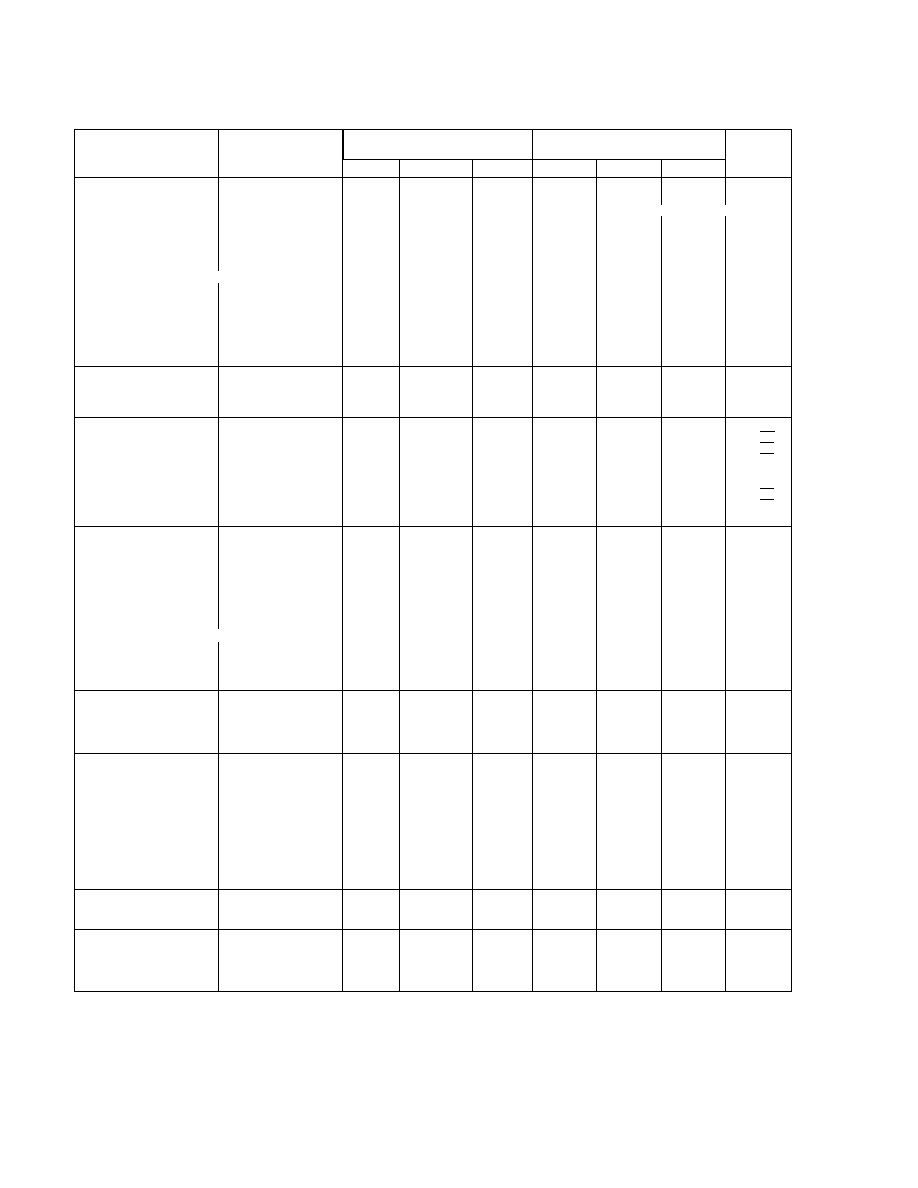
SPECIFICATIONS
At T
A
= +25
∞
C, V
S
=
±
15V, R
L
= 10k
,
unless otherwise noted.
INA128P, U
INA128PA, UA
INA129P, U
INA129PA, UA
PARAMETER
CONDITIONS
MIN
TYP
MAX
MIN
TYP
MAX
UNITS
T
Specification same as INA128P, U or INA129P, U.
NOTE: (1) Input common-mode range varies with output voltage--see typical curves. (2) Guaranteed by wafer test. (3) Temperature coefficient of the 50k
(or 49.4k
)
term in the gain equation. (4) Nonlinearity measurements in G = 1000 are dominated by noise. Typical nonlinearity is
±
0.001%.
INPUT
Offset Voltage, RTI
Initial
T
A
= +25
∞
C
±
10
±
100/G
±
50
±
500/G
±
25
±
100/G
±
125
±
1000/G
µ
V
vs Temperature
T
A
= T
MIN
to T
MAX
±
0.2
±
2/G
±
0.5
±
20/G
±
0.2
±
5/G
±
1
±
20/G
µ
V/
∞
C
vs Power Supply
V
S
=
±
2.25V to
±
18V
±
0.2
±
20/G
±
1
±
100/G
T
±
2
±
200/G
µ
V/V
Long-Term Stability
±
0.1
±
3/G
T
µ
V/mo
Impedance, Differential
10
10
|| 2
T
|| pF
Common-Mode
10
11
|| 9
T
|| pF
Common-Mode Voltage Range
(1)
V
O
= 0V
(V+) ≠ 2
(V+) ≠ 1.4
T
T
V
(V≠)
+ 2
(V≠) + 1.7
T
T
V
Safe Input Voltage
±
40
T
V
Common-Mode Rejection
V
CM
=
±
13V,
R
S
= 1k
G=1
80
86
73
T
dB
G=10
100
106
93
T
dB
G=100
120
125
110
T
dB
G=1000
120
130
110
T
dB
BIAS CURRENT
±
2
±
5
T
±
10
nA
vs Temperature
±
30
T
pA/
∞
C
Offset Current
±
1
±
5
T
±
10
nA
vs Temperature
±
30
T
pA/
∞
C
NOISE VOLTAGE, RTI
G = 1000, R
S
= 0
f = 10Hz
10
T
nV/
Hz
f = 100Hz
8
T
nV/
Hz
f = 1kHz
8
T
nV/
Hz
f
B
= 0.1Hz to 10Hz
0.2
T
µ
Vp-p
Noise Current
f=10Hz
0.9
T
pA/
Hz
f=1kHz
0.3
T
pA/
Hz
f
B
= 0.1Hz to 10Hz
30
T
pAp-p
GAIN
Gain Equation, INA128
1 + (50k
/R
G
)
T
V/V
INA129
1 + (49.4k
/R
G
)
T
V/V
Range of Gain
1
10000
T
T
V/V
Gain Error
G=1
±
0.01
±
0.024
T
±
0.1
%
G=10
±
0.02
±
0.4
T
±
0.5
%
G=100
±
0.05
±
0.5
T
±
0.7
%
G=1000
±
0.5
±
1
T
±
2
%
Gain vs Temperature
(2)
G=1
±
1
±
10
T
T
ppm/
∞
C
50k
(or 49.4k
) Resistance
(2, 3)
±
25
±
100
T
T
ppm/
∞
C
Nonlinearity
V
O
=
±
13.6V, G=1
±
0.0001
±
0.001
T
±
0.002
% of FSR
G=10
±
0.0003
±
0.002
T
±
0.004
% of FSR
G=100
±
0.0005
±
0.002
T
±
0.004
% of FSR
G=1000
±
0.001
(Note 4)
T
T
% of FSR
OUTPUT
Voltage: Positive
R
L
= 10k
(V+) ≠ 1.4
(V+) ≠ 0.9
T
T
V
Negative
R
L
= 10k
(V≠) + 1.4
(V≠) + 0.8
T
T
V
Load Capacitance Stability
1000
T
pF
Short-Circuit Current
+6/≠15
T
mA
FREQUENCY RESPONSE
Bandwidth, ≠3dB
G=1
1.3
T
MHz
G=10
700
T
kHz
G=100
200
T
kHz
G=1000
20
T
kHz
Slew Rate
V
O
=
±
10V, G=10
4
T
V/
µ
s
Settling Time, 0.01%
G=1
7
T
µ
s
G=10
7
T
µ
s
G=100
9
T
µ
s
G=1000
80
T
µ
s
Overload Recovery
50% Overdrive
4
T
µ
s
POWER SUPPLY
Voltage Range
±
2.25
±
15
±
18
T
T
T
V
Current, Total
V
IN
= 0V
±
700
±
750
T
T
µ
A
TEMPERATURE RANGE
Specification
≠40
85
T
T
∞
C
Operating
≠40
125
T
T
∞
C
JA
8-Pin Dip
80
T
∞
C/W
SO-8 SOIC
150
T
∞
C/W

The information provided herein is believed to be reliable; however, BURR-BROWN assumes no responsibility for inaccuracies or omissions. BURR-BROWN assumes no responsibility
for the use of this information, and all use of such information shall be entirely at the user's own risk. Prices and specifications are subject to change without notice. No patent rights or
licenses to any of the circuits described herein are implied or granted to any third party. BURR-BROWN does not authorize or warrant any BURR-BROWN product for use in life support
devices and/or systems.
ELECTROSTATIC
DISCHARGE SENSITIVITY
This integrated circuit can be damaged by ESD. Burr-Brown
recommends that all integrated circuits be handled with ap-
propriate precautions. Failure to observe proper handling and
installation procedures can cause damage.
ESD damage can range from subtle performance degradation
to complete device failure. Precision integrated circuits may
be more susceptible to damage because very small parametric
changes could cause the device not to meet its published
specifications.
ORDERING INFORMATION
PACKAGE
DRAWING
TEMPERATURE
PRODUCT
PACKAGE
NUMBER
(1)
RANGE
INA128PA
8-Pin Plastic DIP
006
≠40
∞
C to +85
∞
C
INA128P
8-Pin Plastic DIP
006
≠40
∞
C to +85
∞
C
INA128UA
SO-8 Surface-Mount
182
≠40
∞
C to +85
∞
C
INA128U
SO-8 Surface-Mount
182
≠40
∞
C to +85
∞
C
INA129PA
8-Pin Plastic DIP
006
≠40
∞
C to +85
∞
C
INA129P
8-Pin Plastic DIP
006
≠40
∞
C to +85
∞
C
INA129UA
SO-8 Surface-Mount
182
≠40
∞
C to +85
∞
C
INA129U
SO-8 Surface-Mount
182
≠40
∞
C to +85
∞
C
NOTE: (1) For detailed drawing and dimension table, please see end of data
sheet, or Appendix C of Burr-Brown IC Data Book.
PIN CONFIGURATION
8-Pin DIP and SO-8
R
G
V
≠
IN
V
+
IN
V≠
R
G
V+
V
O
Ref
1
2
3
4
8
7
6
5
Top View
Supply Voltage ..................................................................................
±
18V
Analog Input Voltage Range .............................................................
±
40V
Output Short-Circuit (to ground) .............................................. Continuous
Operating Temperature ................................................. ≠40
∞
C to +125
∞
C
Storage Temperature ..................................................... ≠40
∞
C to +125
∞
C
Junction Temperature .................................................................... +150
∞
C
Lead Temperature (soldering, 10s) ............................................... +300
∞
C
ABSOLUTE MAXIMUM RATINGS
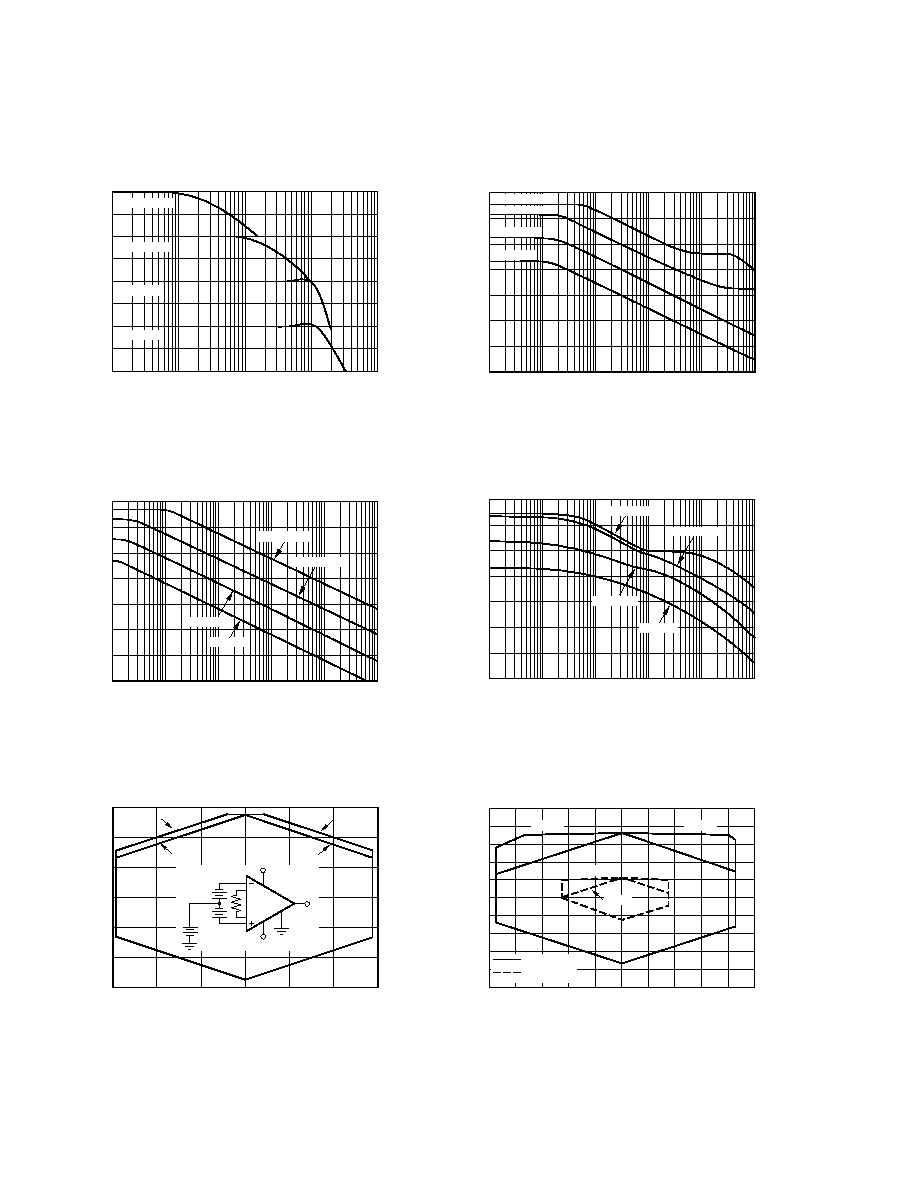
TYPICAL PERFORMANCE CURVES
At T
A
= +25
∞
C, V
S
=
±
15V, unless otherwise noted.
COMMON-MODE REJECTION vs FREQUENCY
Frequency (Hz)
Common-Mode Rejection (dB)
10
100
10k
1M
1k
140
120
100
80
60
40
20
0
100k
G = 1V/V
G = 10V/V
G = 100V/V
G = 1000V/V
POSITIVE POWER SUPPLY REJECTION
vs FREQUENCY
Frequency (Hz)
Power Supply Rejection (dB)
140
120
100
80
60
40
20
0
10
100
1k
10k
100k
1M
G = 100V/V
G = 1000V/V
G = 1V/V
G = 10V/V
INPUT COMMON-MODE RANGE
vs OUTPUT VOLTAGE, V
S
= ±5, ±2.5V
Output Voltage (V)
Common-Mode Voltage (V)
≠5
5
4
3
2
1
0
≠1
≠2
≠3
≠4
≠5
≠4
≠3
≠2
≠1
0
1
2
3
4
5
V
S
= ±5V
V
S
= ±2.5V
G = 1
G = 1
G
10
G
10
G
10
G = 1
NEGATIVE POWER SUPPLY REJECTION
vs FREQUENCY
Frequency (Hz)
Power Supply Rejection (dB)
140
120
100
80
60
40
20
0
10
100
1k
10k
100k
1M
G = 100V/V
G = 1000V/V
G = 1V/V
G = 10V/V
INPUT COMMON-MODE RANGE
vs OUTPUT VOLTAGE, V
S
= ±15V
Output Voltage (V)
Common-Mode Voltage (V)
≠15
≠10
0
5
15
≠5
15
10
5
0
≠5
≠10
≠15
10
G = 1
G = 1
G
10
G
10
V
D/2
≠
+
≠
+
V
CM
V
O
V
D/2
Ref
≠15V
+15V
+
GAIN vs FREQUENCY
60
50
40
30
20
10
0
≠10
≠20
Gain (dB)
Frequency (Hz)
1k
10k
100k
1M
10M
G = 100V/V
G = 10V/V
G = 1V/V
G = 1000V/V

INPUT OVER-VOLTAGE V/I CHARACTERISTICS
5
4
3
2
1
0
≠1
≠2
≠3
≠4
≠5
Input Current (mA)
Input Voltage (V)
≠50
≠40
≠30
≠20
≠10
10
20
30
40
0
50
G = 1V/V
G = 1V/V
G = 1000V/V
G = 1000V/V
V
IN
I
IN
≠15V
+15V
Flat region represents
normal linear operation.
TYPICAL PERFORMANCE CURVES
(CONT)
At T
A
= +25
∞
C, V
S
=
±
15V, unless otherwise noted.
INPUT- REFERRED NOISE vs FREQUENCY
Frequency (Hz)
Input-Referred Voltage Noise (nV/
Hz)
1
10
1k
100
1k
100
10
1
10k
G = 1V/V
G = 10V/V
100
10
1
0.1
Input Bias Current Noise (pA/
Hz)
Current Noise
G = 100, 1000V/V
SETTLING TIME vs GAIN
Gain (V/V)
Settling Time (µs)
100
10
1
1
10
100
1000
0.01%
0.1%
INPUT OFFSET VOLTAGE WARM-UP
10
8
6
4
2
0
≠2
≠4
≠6
≠8
≠10
0
100
200
300
400
500
Time (µs)
Offset Voltage Change (µV)
INPUT BIAS CURRENT vs TEMPERATURE
2
1
0
≠1
≠2
≠75
≠50
≠25
0
25
50
75
100
125
Temperature (∞C)
Input Bias Current (nA)
I
OS
I
B
Typical I
B
and I
OS
Range ±2nA at 25∞C
QUIESCENT CURRENT and SLEW RATE
vs TEMPERATURE
Temperature (∞C)
Quiescent Current (µA)
0.85
0.8
0.75
0.7
0.65
0.6
6
5
4
3
2
1
≠75
≠50
≠25
0
25
50
75
100
125
Slew Rate (V/µs)
I
Q
Slew Rate
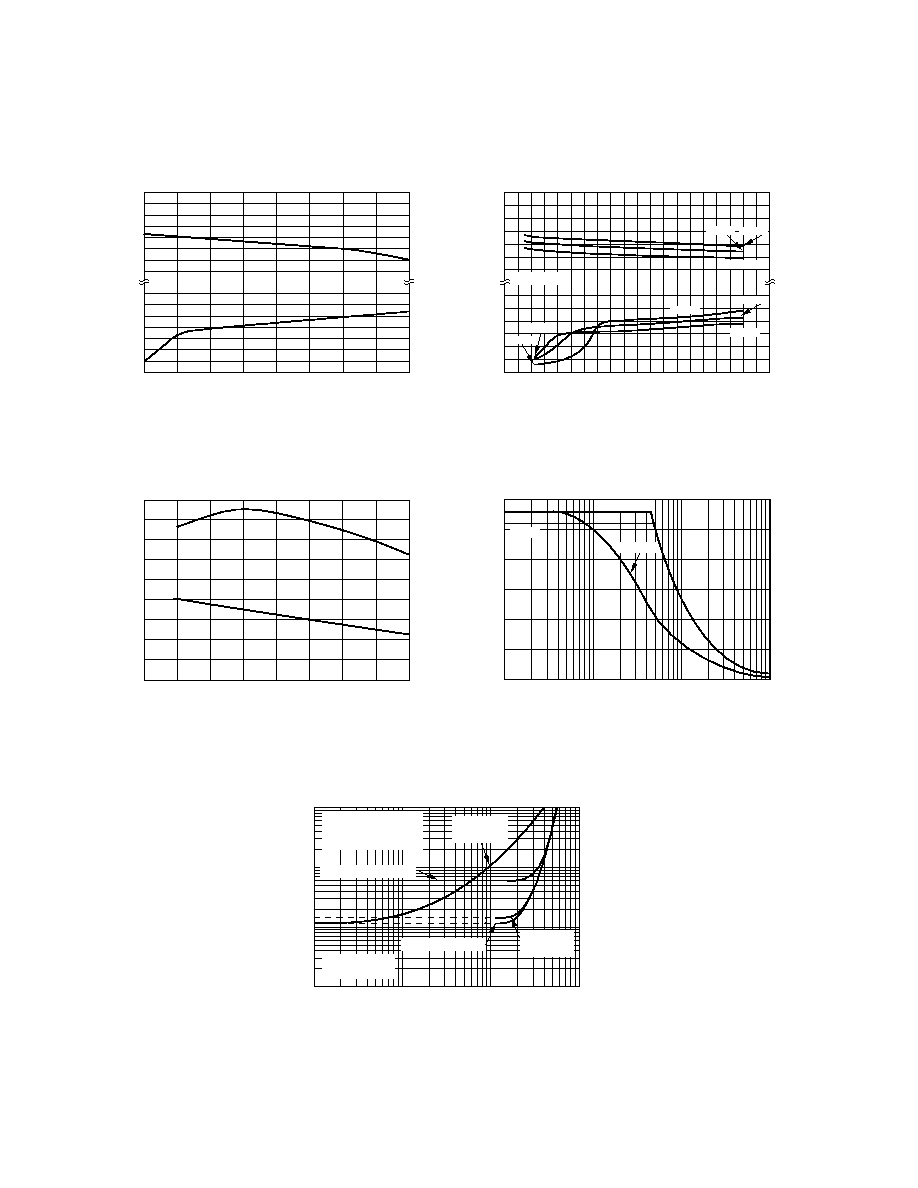
TYPICAL PERFORMANCE CURVES
(CONT)
At T
A
= +25
∞
C, V
S
=
±
15V, unless otherwise noted.
OUTPUT VOLTAGE SWING
vs OUTPUT CURRENT
(V+)
(V+)≠0.4
(V+)≠0.8
(V+)≠1.2
(V+)+1.2
(V≠)+0.8
(V≠)+0.4
V≠
0
1
2
3
4
Output Current (mA)
Output Voltage (V)
OUTPUT VOLTAGE SWING
vs POWER SUPPLY VOLTAGE
V+
(V+)≠0.4
(V+)≠0.8
(V+)≠1.2
(V≠)+1.2
(V≠)+0.8
(V≠)+0.4
V≠
0
5
10
15
20
Power Supply Voltage (V)
Output Voltage Swing (V)
+25∞C +85∞C
≠40∞C
+25∞C
≠40∞C
+85∞C
R
L
= 10k
+85∞C
≠40∞C
SHORT-CIRCUIT OUTPUT CURRENT
vs TEMPERATURE
18
16
14
12
10
8
6
4
2
0
≠75
≠50
≠25
0
25
50
75
100
125
Temperature (∞C)
Short Circuit Current (mA)
≠I
SC
+I
SC
MAXIMUM OUTPUT VOLTAGE vs FREQUENCY
Frequency (Hz)
Peak-to-Peak Output Voltage (Vpp)
30
25
20
15
10
5
0
1k
10k
100k
1M
G = 1
G = 10, 100
G = 1000
TOTAL HARMONIC DISTORTION + NOISE
vs FREQUENCY
Frequency (Hz)
THD + N (%)
100
1k
10k
1
0.1
0.01
0.001
100k
V
O
= 1Vrms
G = 1
R
L
= 10k
G = 10V/V
R
L
= 100k
G = 100, R
L
= 100k
G = 1, R
L
= 100k
500kHz Measurement
Bandwidth
Dashed Portion
is noise limited.
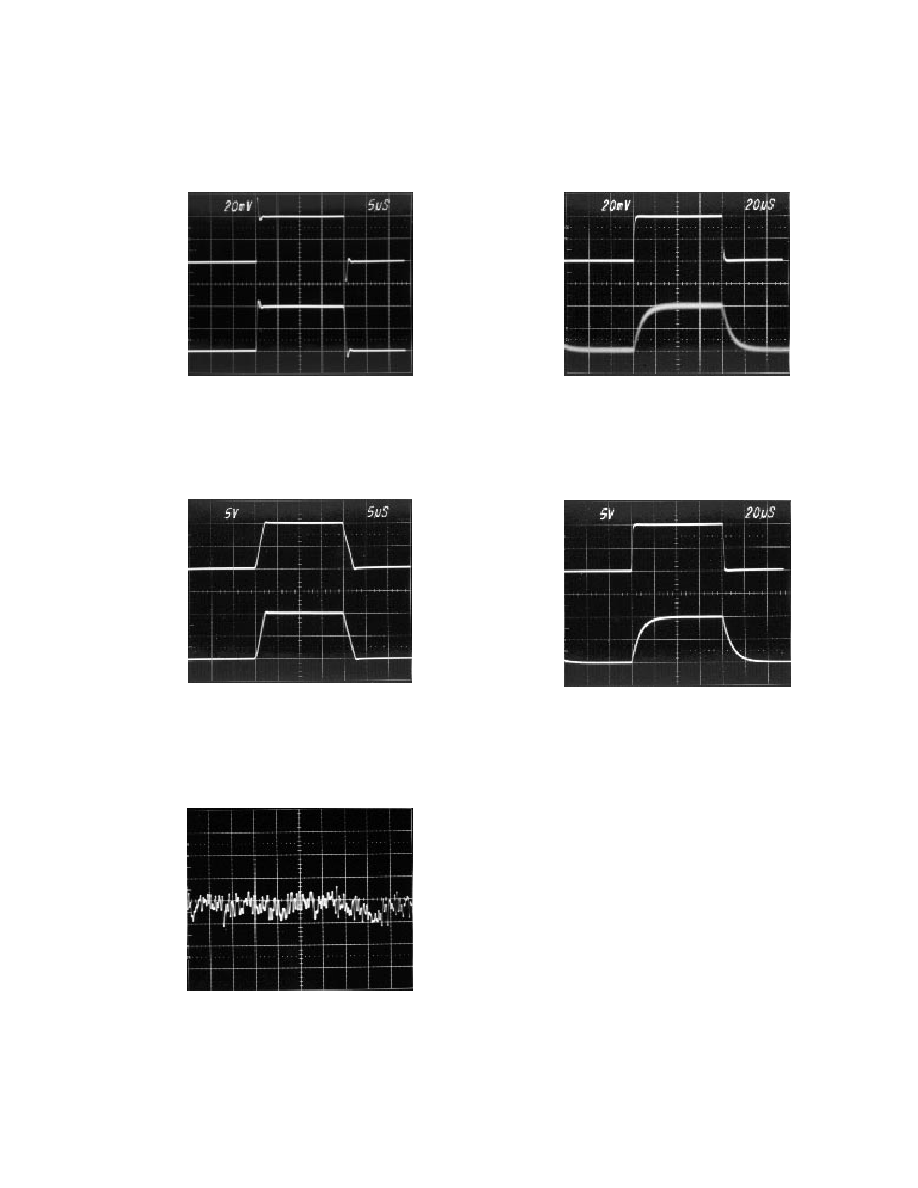
TYPICAL PERFORMANCE CURVES
(CONT)
At T
A
= +25
∞
C, V
S
=
±
15V, unless otherwise noted.
LARGE-SIGNAL
(G = 1, 10)
SMALL-SIGNAL
(G = 100, 1000)
SMALL-SIGNAL
(G = 1, 10)
LARGE-SIGNAL
(G = 100, 1000)
VOLTAGE NOISE 0.1 to 10Hz
INPUT-REFERRED, G
100
20
µ
s/div
5
µ
s/div
20
µ
s/div
5
µ
s/div
1s/div
0.1
µ
V/div
5V/div
G = 1
G = 10
5V/div
G = 100
G = 1000
20mV/div
G = 1
G = 10
20mV/div
G = 100
G = 1000

A
1
A
2
A
3
6
40k
40k
40k
40k
7
4
3
8
1
2
V
IN
V
IN
R
G
V+
V≠
INA128, INA129
≠
+
5
Over-Voltage
Protection
25k
(1)
25k
(1)
Over-Voltage
Protection
Load
V
O
= G ∑ (V
IN
≠ V
IN
)
+
≠
0.1µF
0.1µF
+
≠
V
O
R
G
Also drawn in simplified form:
INA128
Ref
V
O
V
IN
≠
V
IN
+
Ref
NOTE: (1) INA129: 24.7k
APPLICATION INFORMATION
Figure 1 shows the basic connections required for operation
of the INA128/INA129. Applications with noisy or high
impedance power supplies may require decoupling capaci-
tors close to the device pins as shown.
The output is referred to the output reference (Ref) terminal
which is normally grounded. This must be a low-impedance
connection to assure good common-mode rejection. A resis-
tance of 8
in series with the Ref pin will cause a typical
device to degrade to approximately 80dB CMR (G = 1).
SETTING THE GAIN
Gain is set by connecting a single external resistor, R
G
,
connected between pins 1 and 8:
INA129:
(2)
Commonly used gains and resistor values are shown in
Figure 1.
The 50k
term in Equation 1 (49.4k
in Equation 2) comes
from the sum of the two internal feedback resistors of A
1
and
A
2
. These on-chip metal film resistors are laser trimmed to
INA128:
(1)
G
=
1
+
50k
R
G
FIGURE 1. Basic Connections.
accurate absolute values. The accuracy and temperature
coefficient of these internal resistors are included in the gain
accuracy and drift specifications of the INA128/INA129.
The stability and temperature drift of the external gain
setting resistor, R
G
, also affects gain. R
G
's contribution to
gain accuracy and drift can be directly inferred from the gain
equation (1). Low resistor values required for high gain can
make wiring resistance important. Sockets add to the wiring
resistance which will contribute additional gain error (possi-
bly an unstable gain error) in gains of approximately 100 or
greater.
DYNAMIC PERFORMANCE
The typical performance curve "Gain vs Frequency" shows
that, despite its low quiescent current, the INA128/INA129
achieves wide bandwidth, even at high gain. This is due to
the current-feedback topology of the input stage circuitry.
Settling time also remains excellent at high gain.
NOISE PERFORMANCE
The INA128/INA129 provides very low noise in most appli-
cations. Low frequency noise is approximately 0.2
µ
Vp-p
measured from 0.1 to 10Hz (G
100). This provides
dramatically improved noise when compared to state-of-the-
art chopper-stabilized amplifiers.
G
= 1+ 49
.
4
k
R
G
DESIRED
R
G
NEAREST
R
G
NEAREST
GAIN (V/V)
(
)
1% R
G
(
)
(
)
1% R
G
(
)
1
NC
NC
NC
NC
2
50.00k
49.9k
49.4k
49.9k
5
12.50k
12.4k
12.35k
12.4k
10
5.556k
5.62k
5489
5.49k
20
2.632k
2.61k
2600
2.61k
50
1.02k
1.02k
1008
1k
100
505.1
511
499
499
200
251.3
249
248
249
500
100.2
100
99
100
1000
50.05
49.9
49.5
49.9
2000
25.01
24.9
24.7
24.9
5000
10.00
10
9.88
9.76
10000
5.001
4.99
4.94
4.87
NC: No Connection.
INA128
INA129
50k
R
G
INA128:
G = 1 +
INA129:
G = 1 +
49.4k
R
G

OFFSET TRIMMING
The INA128/INA129 is laser trimmed for low offset voltage
and offset voltage drift. Most applications require no exter-
nal offset adjustment. Figure 2 shows an optional circuit for
trimming the output offset voltage. The voltage applied to
Ref terminal is summed with the output. The op amp buffer
provides low impedance at the Ref terminal to preserve good
common-mode rejection.
INPUT BIAS CURRENT RETURN PATH
The input impedance of the INA128/INA129 is extremely
high--approximately 10
10
. However, a path must be pro-
vided for the input bias current of both inputs. This input
bias current is approximately
±
2nA. High input impedance
means that this input bias current changes very little with
varying input voltage.
Input circuitry must provide a path for this input bias current
for proper operation. Figure 3 shows various provisions for
an input bias current path. Without a bias current path, the
inputs will float to a potential which exceeds the common-
mode range, and the input amplifiers will saturate.
If the differential source resistance is low, the bias current
return path can be connected to one input (see the thermo-
couple example in Figure 3). With higher source impedance,
using two equal resistors provides a balanced input with
possible advantages of lower input offset voltage due to bias
current and better high-frequency common-mode rejection.
INPUT COMMON-MODE RANGE
The linear input voltage range of the input circuitry of the
INA128/INA129 is from approximately 1.4V below the
positive supply voltage to 1.7V above the negative supply.
As a differential input voltage causes the output voltage
increase, however, the linear input range will be limited by
the output voltage swing of amplifiers A
1
and A
2
. So the
FIGURE 2. Optional Trimming of Output Offset Voltage.
10k
OPA177
±10mV
Adjustment Range
100
100
100µA
1/2 REF200
100µA
1/2 REF200
V+
V≠
R
G
INA128
Ref
V
O
V
IN
≠
V
IN
+
FIGURE 3. Providing an Input Common-Mode Current Path.
47k
47k
10k
Microphone,
Hydrophone
etc.
Thermocouple
Center-tap provides
bias current return.
INA128
INA128
INA128
linear common-mode input range is related to the output
voltage of the complete amplifier. This behavior also de-
pends on supply voltage--see performance curves "Input
Common-Mode Range vs Output Voltage".
Input-overload can produce an output voltage that appears
normal. For example, if an input overload condition drives
both input amplifiers to their positive output swing limit, the
difference voltage measured by the output amplifier will be
near zero. The output of A
3
will be near 0V even though both
inputs are overloaded.
LOW VOLTAGE OPERATION
The INA128/INA129 can be operated on power supplies as
low as
±
2.25V. Performance remains excellent with power
supplies ranging from
±
2.25V to
±
18V. Most parameters
vary only slightly throughout this supply voltage range--see
typical performance curves. Operation at very low supply
voltage requires careful attention to assure that the input
voltages remain within their linear range. Voltage swing
requirements of internal nodes limit the input common-
mode range with low power supply voltage. Typical perfor-
mance curves, "Input Common-Mode Range vs Output
Voltage" show the range of linear operation for
±
15V,
±
5V,
and
±
2.5V supplies.
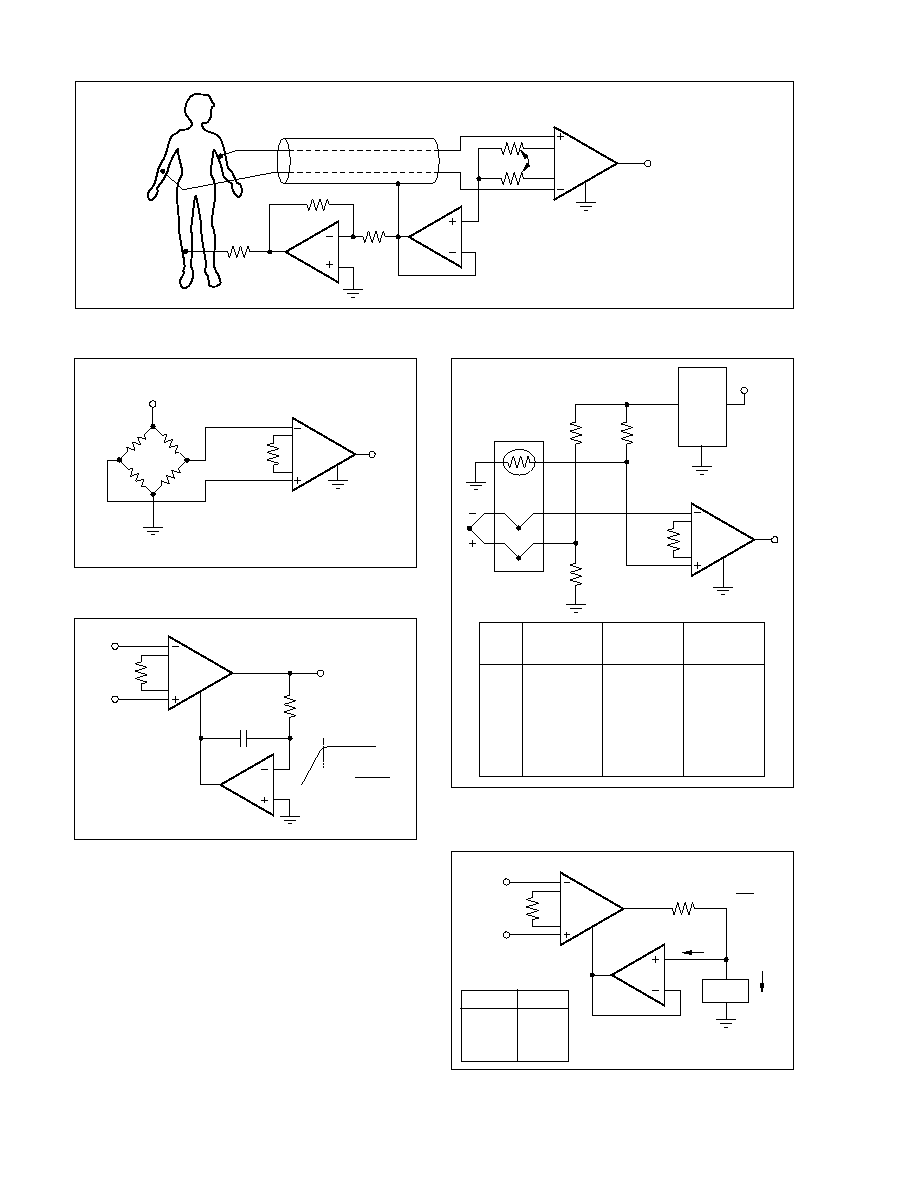
INA128
R
G
V
O
C
1
0.1µF
OPA130
Ref
R
1
1M
f
≠3dB
=
1
2
R
1
C
1
= 1.59Hz
V
IN
+
≠
FIGURE 4. ECG Amplifier With Right-Leg Drive.
FIGURE 8. Differential Voltage to Current Converter.
A
1
I
B
Error
OPA177
±
1.5nA
OPA131
±
50pA
OPA602
±
1pA
OPA128
±
75fA
SEEBECK
ISA
COEFFICIENT
TYPE
MATERIAL
(
µ
V/
∞
C)
R
1
, R
2
E
+ Chromel
58.5
66.5k
≠ Constantan
J
+ Iron
50.2
76.8k
≠ Constantan
K
+ Chromel
39.4
97.6k
≠ Alumel
T
+ Copper
38.0
102k
≠ Constantan
FIGURE 7. Thermocouple Amplifier With RTD Cold-
Junction Compensation.
FIGURE 5. Bridge Amplifier.
FIGURE 6. AC-Coupled Instrumentation Amplifier.
REF102
R
2
R
1
R
3
Pt100
Cu
Cu
V+
K
6
10.0V
4
2
INA128
V
O
Ref
100
= Pt100 at 0∞C
R
G
INA128
R
G
I
B
R
1
V
IN
≠
+
A
1
I
O
Load
I
O
= ∑ G
V
IN
R
1
Ref
INA128
R
G
/2
R
G
= 5.6k
V
O
LA
RL
RA
10k
Ref
NOTE: Due to the INA128's current-feedback
topology, V
G
is approximately 0.7V less than
the common-mode input voltage. This DC offset
in this guard potential is satisfactory for many
guarding applications.
G = 10
2.8k
V
G
V
G
2.8k
1/2
OPA2131
390k
390k
1/2
OPA2131
300
+5V
2.5V ≠
V
2.5V +
V
R
G
INA128
V
O
Ref
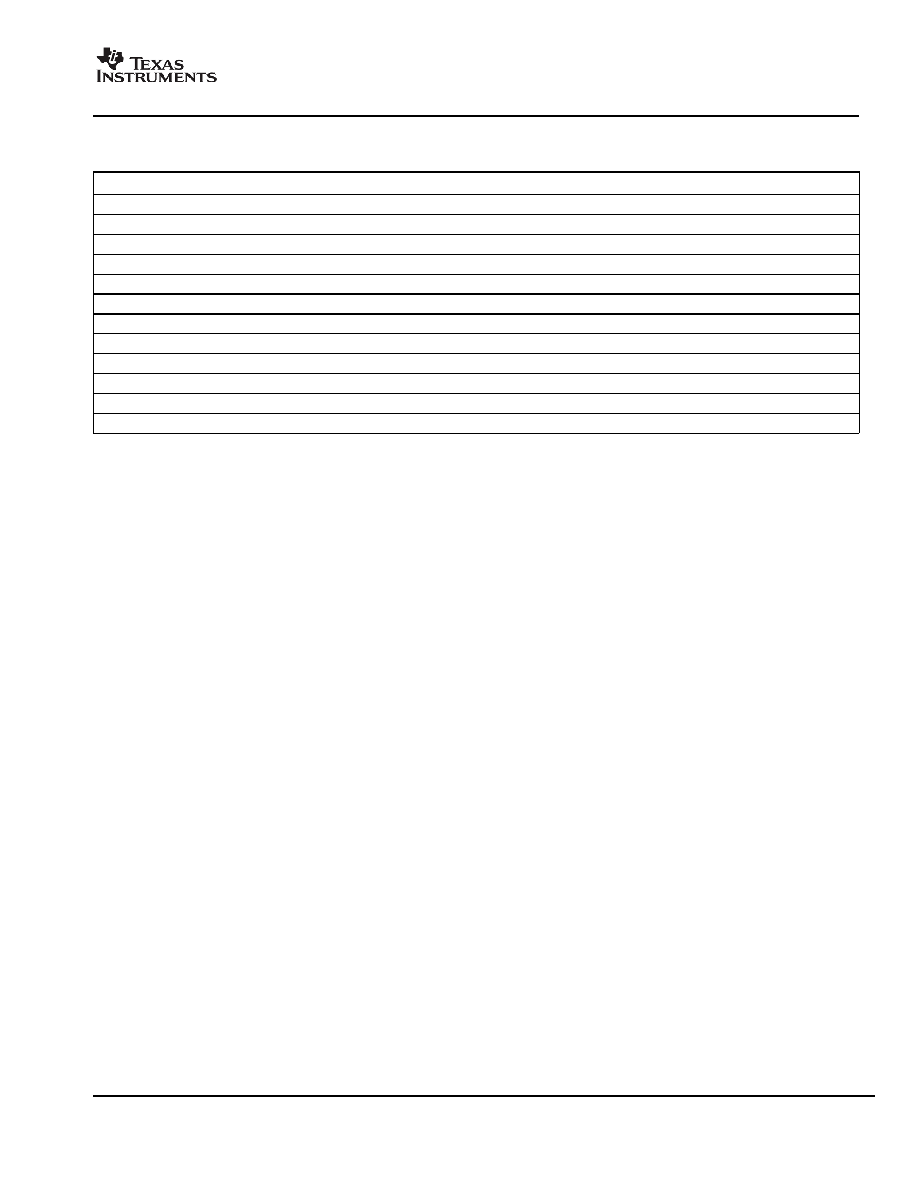
PACKAGING INFORMATION
ORDERABLE DEVICE
STATUS(1)
PACKAGE TYPE
PACKAGE DRAWING
PINS
PACKAGE QTY
INA128P
ACTIVE
PDIP
P
8
50
INA128PA
ACTIVE
PDIP
P
8
50
INA128U
ACTIVE
SOIC
D
8
100
INA128U/2K5
ACTIVE
SOIC
D
8
2500
INA128UA
ACTIVE
SOIC
D
8
100
INA128UA/2K5
ACTIVE
SOIC
D
8
2500
INA129P
ACTIVE
PDIP
P
8
50
INA129PA
ACTIVE
PDIP
P
8
50
INA129U
ACTIVE
SOIC
D
8
100
INA129U/2K5
ACTIVE
SOIC
D
8
2500
INA129UA
ACTIVE
SOIC
D
8
100
INA129UA/2K5
ACTIVE
SOIC
D
8
2500
(1) The marketing status values are defined as follows:
ACTIVE: Product device recommended for new designs.
LIFEBUY: TI has announced that the device will be discontinued, and a lifetime-buy period is in effect.
NRND: Not recommended for new designs. Device is in production to support existing customers, but TI does not recommend using this part in
a new design.
PREVIEW: Device has been announced but is not in production. Samples may or may not be available.
OBSOLETE: TI has discontinued the production of the device.
PACKAGE OPTION ADDENDUM
www.ti.com
3-Oct-2003

IMPORTANT NOTICE
Texas Instruments Incorporated and its subsidiaries (TI) reserve the right to make corrections, modifications,
enhancements, improvements, and other changes to its products and services at any time and to discontinue
any product or service without notice. Customers should obtain the latest relevant information before placing
orders and should verify that such information is current and complete. All products are sold subject to TI's terms
and conditions of sale supplied at the time of order acknowledgment.
TI warrants performance of its hardware products to the specifications applicable at the time of sale in
accordance with TI's standard warranty. Testing and other quality control techniques are used to the extent TI
deems necessary to support this warranty. Except where mandated by government requirements, testing of all
parameters of each product is not necessarily performed.
TI assumes no liability for applications assistance or customer product design. Customers are responsible for
their products and applications using TI components. To minimize the risks associated with customer products
and applications, customers should provide adequate design and operating safeguards.
TI does not warrant or represent that any license, either express or implied, is granted under any TI patent right,
copyright, mask work right, or other TI intellectual property right relating to any combination, machine, or process
in which TI products or services are used. Information published by TI regarding third-party products or services
does not constitute a license from TI to use such products or services or a warranty or endorsement thereof.
Use of such information may require a license from a third party under the patents or other intellectual property
of the third party, or a license from TI under the patents or other intellectual property of TI.
Reproduction of information in TI data books or data sheets is permissible only if reproduction is without
alteration and is accompanied by all associated warranties, conditions, limitations, and notices. Reproduction
of this information with alteration is an unfair and deceptive business practice. TI is not responsible or liable for
such altered documentation.
Resale of TI products or services with statements different from or beyond the parameters stated by TI for that
product or service voids all express and any implied warranties for the associated TI product or service and
is an unfair and deceptive business practice. TI is not responsible or liable for any such statements.
Following are URLs where you can obtain information on other Texas Instruments products and application
solutions:
Products
Applications
Amplifiers
amplifier.ti.com
Audio
www.ti.com/audio
Data Converters
dataconverter.ti.com
Automotive
www.ti.com/automotive
DSP
dsp.ti.com
Broadband
www.ti.com/broadband
Interface
interface.ti.com
Digital Control
www.ti.com/digitalcontrol
Logic
logic.ti.com
Military
www.ti.com/military
Power Mgmt
power.ti.com
Optical Networking
www.ti.com/opticalnetwork
Microcontrollers
microcontroller.ti.com
Security
www.ti.com/security
Telephony
www.ti.com/telephony
Video & Imaging
www.ti.com/video
Wireless
www.ti.com/wireless
Mailing Address:
Texas Instruments
Post Office Box 655303 Dallas, Texas 75265
Copyright
2003, Texas Instruments Incorporated











